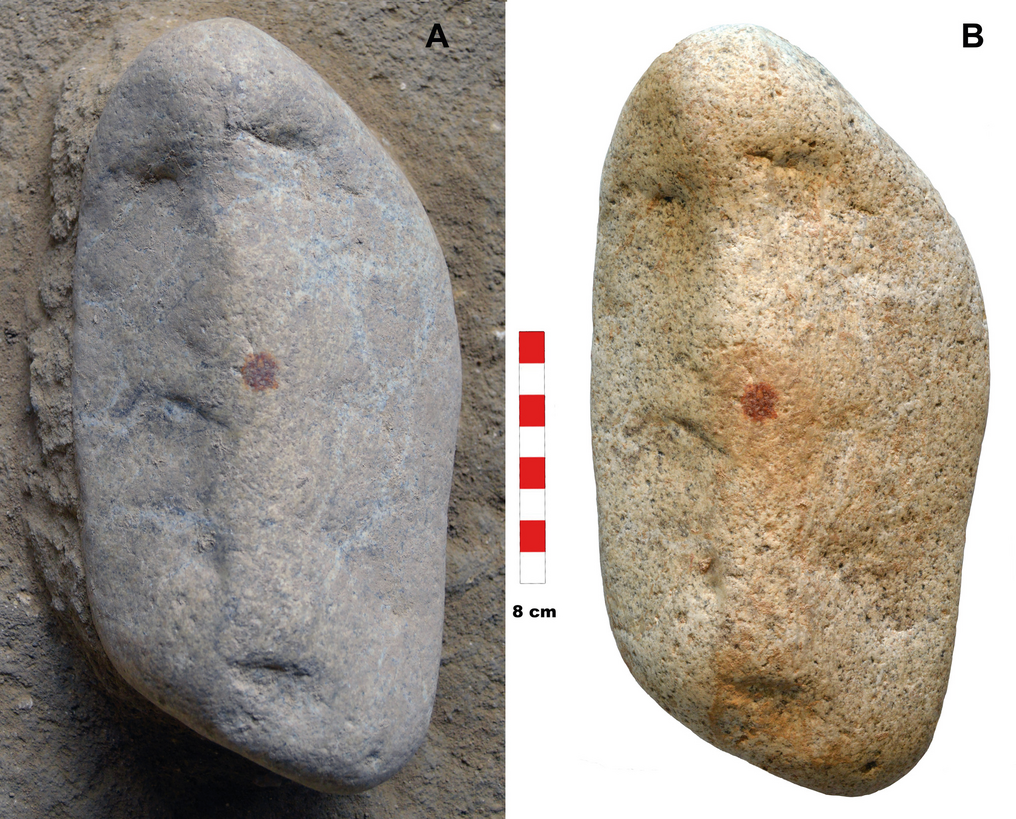A small stone found in a central Spanish rock shelter has revealed what may be the oldest known human fingerprint in Europe—and possibly the earliest symbolic depiction of a face. Dated to approximately 43,000 years ago, the artifact bears a red ocher mark with a complete dermatoglyphic impression, likely left by a Neanderthal. Researchers suggest that the pebble may represent one of the earliest known abstractions of a human face in prehistory.
Discovery at San Lázaro Rock-Shelter
The object was recovered from the San Lázaro rock-shelter, located in the Eresma River valley near Segovia, Spain. The excavation, carried out in July 2022, unearthed the pebble in Level H—a stratigraphic layer dated to between 43,000 and 42,000 years ago. This sediment layer, composed of fine sand and sandy silt, contains clear evidence of Mousterian occupation and has yielded tools produced using Levallois and discoid techniques, along with Mousterian points and Quina sidescrapers. No evidence of Homo sapiens presence has been found at the site.
The pebble is made of quartz-rich leucogranite, measures 21.4 x 11.3 x 7.6 cm, and was transported from the Eresma River, which runs several meters below the shelter. According to the study published in the journal Archaeological and Anthropological Sciences, the pebble was intentionally brought into the shelter, as “no depositional agents with sufficient energy” could have introduced it naturally. It is the largest pebble recovered from the archaeological level and the only one with traces of ocher.
Red Ocher Mark With Fingerprint
The pebble features three natural concavities or “cupules” on one of its faces. Positioned centrally between them is a subcircular red dot. Forensic analysis revealed a human fingerprint embedded in the pigment. This print, known as a dermatoglyphic image, was identified using multispectral imaging, scanning electron microscopy (SEM), and X-ray fluorescence spectroscopy (XRF).
The fingerprint was examined by forensic experts at the General Headquarters of the Forensic Police (Spain). Using techniques including UV reflectography and the ABIS identification system, specialists confirmed it as a full fingerprint. Thirteen distinct minutiae were identified: six abrupt ends, five convergences, and two bifurcations. The average ridge width was 0.48 mm, with a minimum of 0.39 mm and a maximum of 0.61 mm. The fingerprint was likely made by an adult male.

According to the research team, which includes scientists from the Complutense University of Madrid and the Geological and Mining Institute of Spain (IGME-CSIC), “the ocher dot does not appear as a shapeless addition or a mere stain; rather, it contains a fingerprint that implies the pigment has been applied specifically with the tip of a finger soaked in pigment.”
Deliberate Placement and Possible Symbolic Intent
The ocher mark was not randomly applied. The researchers conducted a geometric and statistical analysis of its placement in relation to the three cupules. The dot is located in a central position, equidistant from two of the depressions and forming a triangular configuration with the third. A Monte Carlo simulation concluded there was only a 0.31% chance that this arrangement occurred by accident. Further statistical tests, including the Clark-Evans test and Ripley’s K function, supported the conclusion that the mark was intentional.
Multispectral analysis also detected a photoluminescent response in the ocher under infrared light, and UV imaging confirmed the presence of chemical compounds exclusively in the red dot. No other part of the pebble exhibited similar reactions.
The SEM confirmed the pigment was ocher, composed of iron oxides and clay minerals. No organic binders or other materials were found, and the chemical signature was distinct from the granite surface, confirming the red substance had been applied rather than occurring naturally.

No Evidence of Functional Use
The pebble lacks any signs of functional wear. Detailed 3D surface modeling and comparison with 23 other pebbles found in the same stratigraphic level showed no marks from use as a hammerstone or anvil. Most other pebbles were smaller, rounded, and showed extensive percussion marks. In contrast, the analyzed stone was angular, and lacked any utilitarian modifications.
The largest of the three cupules—located opposite the ocher dot—was found to have an irregular profile, possibly indicating human modification. The other two cupules were more regular and determined to be natural features.
According to the study authors, “this pebble stands out due to its size, morphology, and surface characteristics… it is the only one in which ocher has been identified.”
Hypothesis of Symbolic Face Representation
The researchers propose that the arrangement of the cupules and the red dot may represent a symbolic face—a hypothesis grounded in the psychological phenomenon of face pareidolia. This is the tendency of the human brain to perceive facial features in inanimate objects.
The study notes that “the red dot is not placed randomly and there is a deliberate composition,” suggesting the act of marking the stone was intentional and possibly representational. The possibility of face perception is supported by symmetry and proportionality in the placement of the elements on the pebble’s surface.
While the researchers acknowledge the limitations of interpreting intentions from such ancient material, they argue that the deliberate selection, transport, and marking of the pebble indicates symbolic thinking. They write, “this object contributes to our understanding of Neanderthals’ capacity for abstraction, suggesting that it could represent one of the earliest human facial symbolizations in Prehistory.”
The fingerprint is not the first associated with Neanderthals. A partial print was previously found in ancient resin at the Königsaue site in Germany, but the Spanish find is the most complete example known to date and the first associated with applied pigment.

